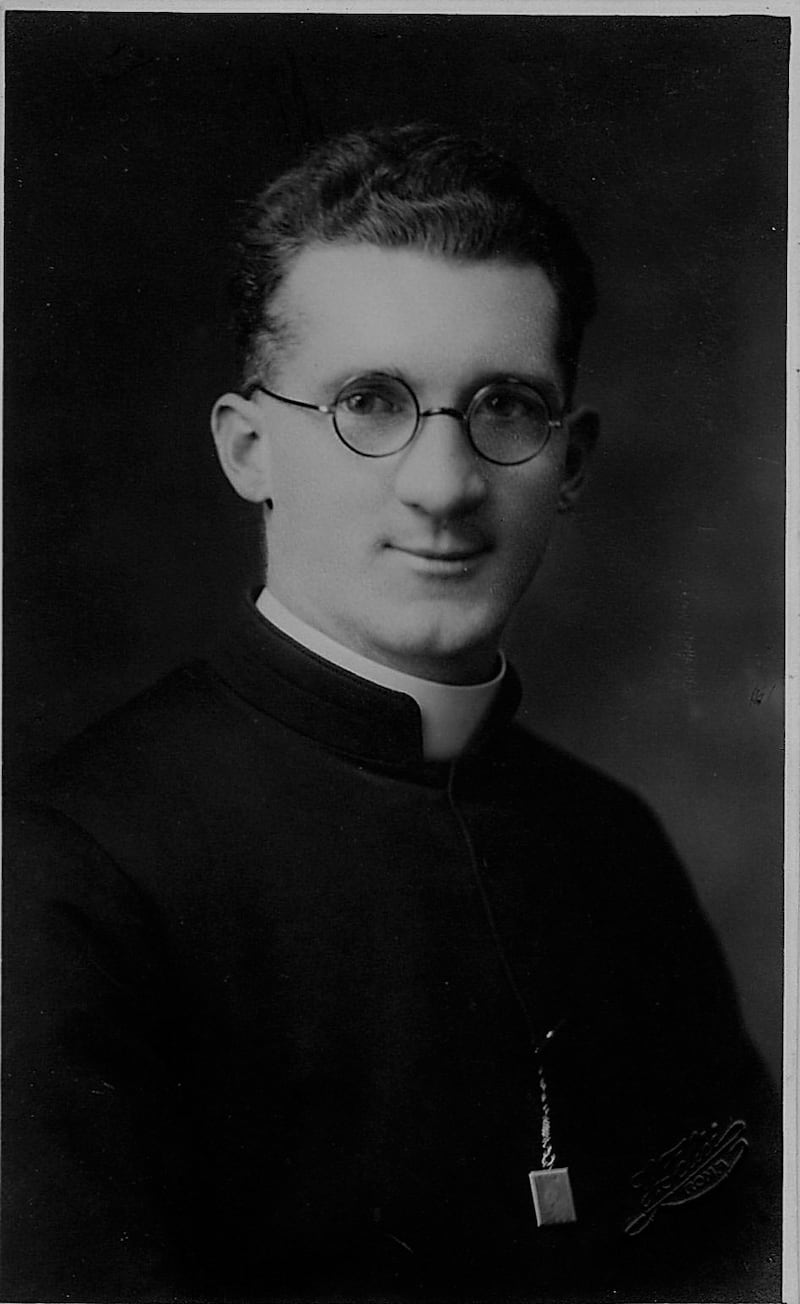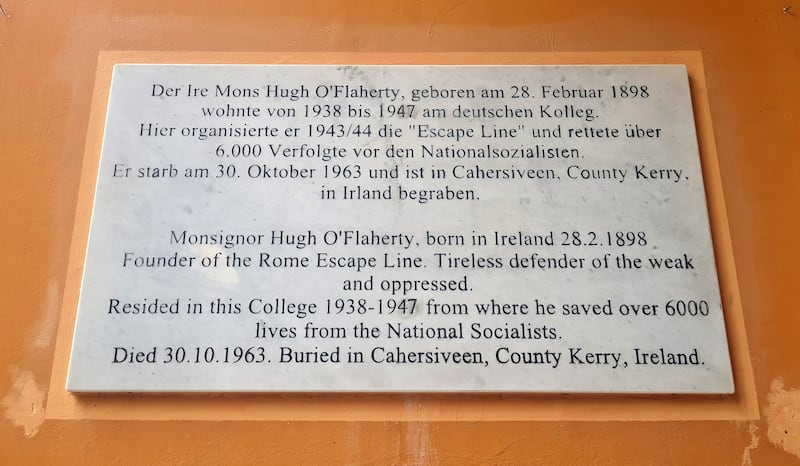An Irish priest who ran a resistance network in Nazi-occupied Rome credited with saving the lives of 6,500 people has been honoured on the steps of the Vatican on the 60th anniversary of his death.
Monsignor Hugh O’Flaherty, born in Cork and raised in Killarney, was based in the pontifical German College throughout the Nazi occupation of Rome of 1943-44, when German forces seized the city and worked to exterminate its resistance and Jewish population.
“His work was extraordinary, and it took great courage,” President Michael D Higgins, said as he laid a wreath at a plaque that commemorates O’Flaherty at the German College. He said it was important to honour “the terrible, tragic events which people had to transcend in that period”.
The engagement was part of a trip to Rome in which Higgins met with Pope Francis, made speeches at UN agencies about food security, migration and climate change, and expressed criticism of an overly supportive European attitude to Israel as it bombards Gaza.
How one couple turned their passion for chocolate into a thriving business
Beautifully renovated South Circular Road three-bed for €925,000
The Stolen Girl: Bingeable, fun and instantly forgettable child kidnap potboiler with Denise Gough
Have your say: Who is the greatest Irish sports star of them all?
Monsignor Stefan Heid, a historian based at the German College who produced a booklet about O’Flaherty’s life, said the Irishman is a “great model” to look to in the troubled times of today.
“I would say today, if there was a Palestinian persecuted, Christian or Muslim, he would help,” Heid said.

O’Flaherty was part of the Vatican’s diplomatic service and was given the task of monitoring political developments in Germany in the 1930s, placed inside the German College where he would be surrounded by the language.
“Ireland was neutral in those times, so an Irish priest could stay here,” Heid explained.
As the second World War raged and Italy was allied to Germany in 1941, O’Flaherty was charged with visiting prisoner-of-war camps in northern Italy and relaying prisoners’ names to their families over Vatican Radio.
This background meant that when the regime of Italian fascist dictator Benito Mussolini collapsed and German forces invaded Italy and occupied Rome in 1943, he knew what would follow and had a network of anti-fascist resistance operators to hand.
“Rome was full of refugees. Not only Jews, but every kind of persecuted people who thought they’d be safe in Italy,” Heid recalled. “This was a big mistake.”
Against the efforts of the Gestapo, O’Flaherty worked with a team of international sympathisers to shuttle people into 200 safe houses: rented flats, rooms with Italian families or hideouts in religious institutions. It became known as the “Rome Escape Line”.
They were given rations, clothes and false identity papers that often stated they were Vatican employees. Fifty refugees moved into the German College itself, hoping they would be protected by the Vatican’s neutral umbrella. But times were perilous.
“The fear was that the Germans, the Nazis or the fascists could come inside and occupy the German College,” Heid recalled. “This was a real threat.”
The college is extraterritorial Vatican jurisdiction, like an embassy, that adjoins the Vatican’s state borders. This ambiguous status meant O’Flaherty could slip in and out without passing guard posts, adopting a range of disguises as the Gestapo began to hunt him, including as a workman, postman and nun.
A British soldier, Sam Derry, briefly stayed in O’Flaherty’s room and went about in the Monsignor’s cassock with false Irish identity papers as he worked to help others escape.
Derry later wrote of the celebration of Christmas day at the college in 1943.
“There were priests of half a dozen different nationalities, who all helped in the work of the organisation ... and a large number of unusual personalities who had been hiding in various parts of the college before my arrival,” Derry recalled.
Irish traditional songs were sung, and O’Flaherty celebrated mass for the Catholics and British Protestants alike.
The nuns who were now catering for 50 refugees on top of 20 priests recalled O’Flaherty in their records as a dab hand at procuring extra supplies on the black market.
The darkest day fell on October 16th, 1943, when Nazi forces raided Rome’s ancient Jewish neighbourhood, deporting its population almost in its entirety and sending them to their deaths.

Hubert Jedin, a German priest who was confined within the walls of the college throughout the occupation because he was half Jewish, recalled in his writings that O’Flaherty appeared “in the highest state of agitation” after witnessing Jewish people being removed “like animals” in carts.
O’Flaherty vowed to confront the German ambassador and declared that “if Germans were committing such crimes, Ireland should not tolerate its German envoy any longer,” Jedin recalled.
Rome became the first capital to be liberated by Allied forces, in June 1944. The refugees hidden around the city and inside the German College poured out.
O’Flaherty later flew to Palestine to help relocate some of the Jewish people he had helped during the occupation. In later years, he suffered a stroke and returned to Ireland, living the rest of his life with his sister in Cahersiveen. His life has been the subject of several books, including Joseph O’Connor’s latest novel My Father’s House, and a 1983 film The Scarlet and the Black, starring Gregory Peck.
“I’m sure we have nothing of his courage here today, if the same times come again,” Heid remarked.
“We had to wait for an Irish priest in a German college to help those persecuted by the Germans,” Heid said. “His biggest friends in the organisation were British. They knew that this was very special, this friendship. They said: in these times, we forget nationalities.”














